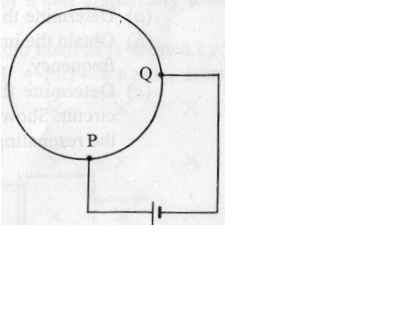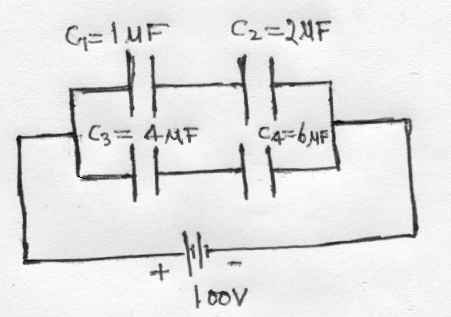|
Model Sample Paper - 2 Q.1.Why the current should not be passed
through potentiometer ire for long time? Q.2. Why does a paramagnetic sample display
greater magnetization when cooled? Q.3.The charging current for a capacitor is
1 ampere. What is the displacement current across its plates? Q.4.Can electric potential at any, point in
space be zero which intensity of electric field at that point is not zero? Q.5. The diffraction pattern becomes
invisible when the slit is very wide. Why? Q.6.Assuming that the dimmest star visible
to the naked eye has a magnitude 6,compare its brightness with that of planet
Venus. The magnitude of Venus is = -4. Q.7.Why is a potentiometer preferred over a
voltmeter for the measurement of emf of a cell. Q.8. If a student by mistake Connects
voltmeter in series with or an ammeter in parallel Of a circuit what will
happen? Q.9. Draw a diagram of Whetstone's bridge.
Obtain the condition of balance. Why a very low resistance cannot be
determined accurately by this bridge? Q.10.Prove that light has transverse wave
native. Q.11.A glass sphere of 15-cm radius has a
small bubble 6-cm from the center. The bubble is seen along a diameter of the
sphere from the side on which it lies. How far from the surface will it
appear to be if refracting index of glass is 1.5? Q.12.Two prisms are made of materials of
dispersing power w1 and w2 . What is the relation between their angles so
that combination produces dispersion without deviation ? Q.13.Explain Copernicus method to find the
distance of inferior planets. Q.14.Define resistance of a conductor. What
is its cause? Explain the factors on which the resistance of a conductor
depends. Q.15.Three charges +q, + q and - q are
situated at the corners of an equilateral triangle whose side is 'a'.
Calculate electric potential energy of system. Q.16.An electron beam moving with uniform
velocity is gradually diverging. When it is accelerated to a very high velocity,
it again starts converging. Why ? Q.17.Calculate the energy and momentum of a
photon of wavelength 6600 A. ( h = 6.6 X 10-34 j-s) Q.18.Derive a relation between current gain
of common base amplifier and current gain of common emitter amplifier. Q.19.Draw a labelled diagram of a dry cell.
Explain its action with the help of chemical reactions taking place inside
the cell. Q.20.Draw the logic symbol and write the
truth table of OR gate. With the help of a circuit diagram describe the
realization of NOR gate using n-p-n transistor. Q.21.A cell is connected across two points
P and Q of a uniform circular conductor. Prove that the magnetic field at its center O will he zero. |
|
|
|
Q.22.A magnetic dipole is under the
influence of two magnetic fields. The angle between the field direction is 600and one of the
fields has a magnitude of 1.2 x 10-2 T. If the dipole comes to
stable equilibrium at an angle of 150 with this field, what is the
magnitude of the others field ? Q.23.A resistor of 12 W, a capacitor of
reactance 14 W and pure inductor of inductance 0. 1 H are joined in series and placed across 200 V, 50 Hertz
a.c supply. Calculate (i) the current in the circuit (ii) phase angle between
current and voltage. Q.24.In a plane electromagnetic wave, the
electric field oscillates sinusoidally at a frequency of 2.0 x 1010 Hz
and amplitude 48 V/m. (a) What is the wavelength of the wave? (b) What is the
amplitude of the oscillating magnetic field? (c) Find the total average
energy density of the electromagnetic field of the waves. Q.25. The wavelength of the first member of
Blamer series in hydrogen spectrum is 6563 A. Calculate wavelength of first
member of Lyman series in the same spectrum. Q.26. Draw and explain characteristic curve
of pn junction when it is forward biased. Q.27. Describe the working of an
astronomical telescope. Give an expression for it's magnifying power. Q.28.State the postulates of Bohr's theory
of atomic model. Use them to obtain the general formula for the wave numbers
of the spectral lines of hydrogen. Q.29.Two capacitors of capacitance C1 and C2 are having charge q1 and q2 respectively. What is the potential difference between conductors of each capacitor? If the two capacitors be joined in parallel what would he the common potential difference between their conductors? Further show that there always occurs a loss in energy when two capacitors with unequal potential difference between their conductors are joined in parallel. In the arrangement shown below, find (i) the equivalent capacity (ii)P.D. across each capacitor (iii) charge on each capacitor |
|
|
|
Q.30. Figure shows a series LCR circuit connected to a variable frequency 230 V source L = 50 H, C = 80 m f, R = 40 W (a) Determine the source frequency which drives the circuit in resonance. (b) Obtain the irnpedance of the circuit and amplitude of current at resonating frequency. (c) Determine the r.m.s. potential drops across the three elements of the circuit. Show that the potential drop across the LC combination is zero at the resonating frequency. |

